Chapter 7.2. Complex Loops – Exam Problems
We have already learned how to execute a particular command block more than once by using a for loop. In the previous chapter we reviewed several other loop constructions, which could help us solve more complex problems:
- loops with a step
- nested loops
whileloopsdo-whileloops- endless loops and breaking out of loops (
breakoperator) try-catchconstruction
Exam Problems
Let's consolidate our knowledge by solving several more complex loop problems from practical exams.
Problem: Stupid Password Generator
Write a program that enters two integers n and l and generates, in alphabetical order, all possible "stupid” passwords" that consist of the following 5 characters:
- Character 1: a digit from 1 to n.
- Character 2: a digit from 1 to n.
- Character 3: a small letter from the first l letters of the Latin alphabet.
- Character 4: a small letter from the first l letters of the Latin alphabet.
- Character 5: a digit from 1 to n, greater than the first 2 digits.
Input Data
The input is read from the console and consists of two integers: n and l within the range [1 … 9], each on a single line.
Output Data
Print on the console all "stupid" passwords in alphabetical order, separated by space.
Sample Input and Output
| Input | Output | Input | Output |
|---|---|---|---|
| 2 4 |
11aa2 11ab2 11ac2 11ad2 11ba2 11bb2 11bc2 11bd2 11ca2 11cb2 11cc2 11cd2 11da2 11db2 11dc2 11dd2 | 3 1 |
11aa2 11aa3 12aa3 21aa3 22aa3 |
| Input | Output | Input | Output |
|---|---|---|---|
| 3 2 |
11aa2 11aa3 11ab2 11ab3 11ba2 11ba3 11bb2 11bb3 12aa3 12ab3 12ba3 12bb3 21aa3 21ab3 21ba3 21bb3 22aa3 22ab3 22ba3 22bb3 | 4 2 |
11aa2 11aa3 11aa4 11ab2 11ab3 11ab4 11ba2 11ba3 11ba4 11bb2 11bb3 11bb4 12aa3 12aa4 12ab3 12ab4 12ba3 12ba4 12bb3 12bb4 13aa4 13ab4 13ba4 13bb4 21aa3 21aa4 21ab3 21ab4 21ba3 21ba4 21bb3 21bb4 22aa3 22aa4 22ab3 22ab4 22ba3 22ba4 22bb3 22bb4 23aa4 23ab4 23ba4 23bb4 31aa4 31ab4 31ba4 31bb4 32aa4 32ab4 32ba4 32bb4 33aa4 33ab4 33ba4 33bb4 |
Hints and Guidelines
We can split the solution into three parts:
- Read the input – for the current problem this consists of reading two numbers
nandl, each on a single line. - Process the input – use nested loops to iterate through every possible character for each of the five password characters.
- Print the result – print each "stupid" password that meets the requirements.
Read The Input
To read the input we will declare two integer variables int: n and l.

Let's declare and initialize the variables, which will store the characters of the password: for the numeric characters - int - d1, d2, d3, and for the letters - char - l1, l2.
Processing The Input Data and Printing Output
We have to create five nested for loops, one for each variable. To ensure that the last digit d3 is greater than the first two, we will use the built-in function Math.max(…).
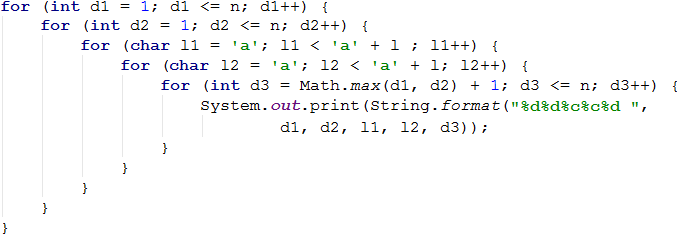
Do Y ou Know That…?
- We can define a
forloop with a variable of typechar:

- We can read a variable of type
charfrom the console by using the following structure:

- We can convert an uppercase character to lowercase by using the built-in function in Java:

- When reading characters from the console, we can directly convert uppercase letters to lowercase letters by combining the two lines above:

Testing in The Judge System
Test your solution here: https://judge.softuni.org/Contests/Practice/Index/660#0.
Problem: Magic Combination
Write a program that reads a magic integer number and generates all possible 6-digit numbers, for which the product of their digits is equal to the magic number.
Example: "Magic number" → 2
- 111112 → 1 * 1 * 1 * 1 * 1 * 2 = 2
- 111121 → 1 * 1 * 1 * 1 * 2 * 1 = 2
- 111211 → 1 * 1 * 1 * 2 * 1 * 1 = 2
- 112111 → 1 * 1 * 2 * 1 * 1 * 1 = 2
- 121111 → 1 * 2 * 1 * 1 * 1 * 1 = 2
- 211111 → 2 * 1 * 1 * 1 * 1 * 1 = 2
Input Data
The input is read from the console and consists of one integer within the range [1 … 600 000].
Output Data
Print on the console all magic numbers, separated by space.
Sample Input and Output
| Input | Output | Input | Output | Input | Output |
|---|---|---|---|---|---|
| 2 | 111112 111121 111211 112111 121111 211111 | 8 | 111118 111124 111142 111181 111214 111222 111241 111412 111421 111811 112114 112122 112141 112212 112221 112411 114112 114121 114211 118111 121114 121122 121141 121212 121221 121411 122112 122121 122211 124111 141112 141121 141211 142111 181111 211114 211122 211141 211212 211221 211411 212112 212121 212211 214111 221112 221121 221211 222111 241111 411112 411121 411211 412111 421111 811111 | 531441 | 999999 |
Hints and Guidelines
The solution of the magic numbers problem follows the same principle (again we have to generate all combinations for several elements). Try to solve the problem yourself by following these steps.
- Declare and initialize a variable of type
intand read the input from the console. - Nest six
forloops into each other, one for each digit of the required 6-digit numbers. - In the last loop, use an
ifconstruction to check if the product of the six digits is equal to the magic number.
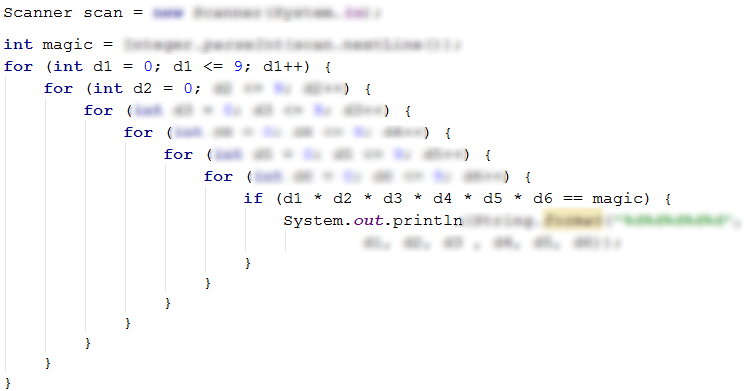
In the previous chapter, we reviewed other loop constructions. Let's check a sample solution of the same problem, where we use a while cycle.
First, we have to store the entered magic number in a suitable variable. After that, we initialize 6 variables - one for each of the six digits of the numbers we have to output as a result.
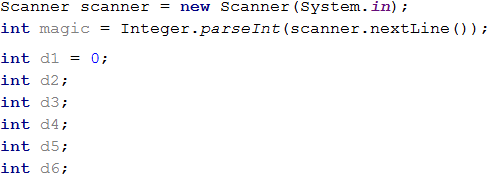
After that, we start constructing the while loops.
- We initialize the first digit:
d1 = 0. - We set a condition for each loop: the digit has to be lower than or equal to 9.
- At the start of each loop, we set the value of the next digit, in this case:
d2 = 0. In the nestedforloops, we initialize the variables in the inner loops with each incrementation of the outer loops. We want to achieve the same behavior here as well. - At the end of each loop, we increase the digit by one:
d++. - In the innermost loop we do the check and, if necessary, print on the console.
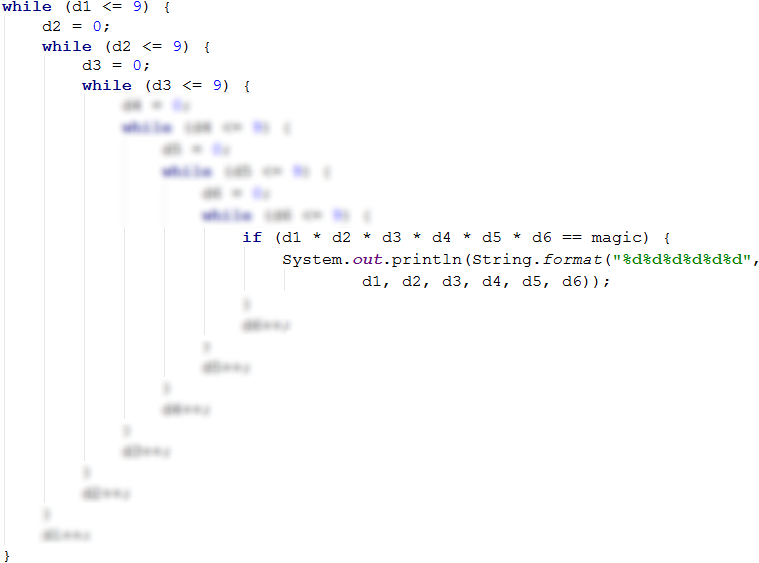
Let's remove the if check from the innermost loop. Now, let's initialize each variable outside the loops and delete the lines dx = 0. After we start the program, we get only 10 results. Why? And what if we use a do-while loop? In our case this loop doesn't seem suitable, does it? Think about why. Of course, you can also solve the problem by using an endless loop.
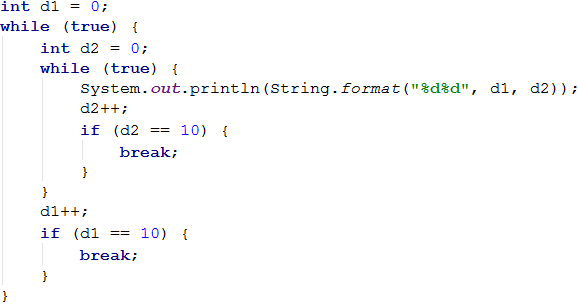
As we can see, we can solve the same problem by using different types of loops. Of course, there is a most suitable choice for each problem. To practice each type of loop, try to solve each of the following problems by using every type of loop we've learned so far.
Testing in The Judge System
Test your solution here: https://judge.softuni.org/Contests/Practice/Index/660#1.
Problem: Stop Number
Write a program that prints on the console all numbers from N to M that are divisible by 2 and 3 without remainder, in reversed order. We will read from the console one additional "stop" number S. If any of the numbers divisible by 2 and 3 is equal to the stop number, it should not be printed and the program should end. Otherwise, print all numbers up to N that meet the condition.
Input Data
Read from the console 3 numbers, each on a single line:
- N - integer number: 0 ≤ N < M.
- M - integer number: N < M ≤ 10000.
- S - integer number: N ≤ S ≤ M.
Output Data
Print on the console, on a single line, all numbers that meet the condition, separated by space.
Sample Input and Output
| Input | Output | Comments |
|---|---|---|
| 1 30 15 |
30 24 18 12 6 | The numbers from 30 to 1 that are divisible by both 2 and 3 without remainder are: 30, 24, 18, 12 and 6. The number 15 is not equal to any of them, so the sequence continues. |
| Input | Output | Comments |
|---|---|---|
| 1 36 12 |
36 30 24 18 | The numbers from 36 to 1 that are divisible by both 2 and 3 without remainder are: 36, 30, 24, 18, 12 and 6. The number 12 is equal to the stop number, so we stop at 18. |
| Input | Output |
|---|---|
| 20 1000 36 |
996 990 984 978 972 966 960 954 948 942 936 930 924 918 912 906 900 894 888 882 876 870 864 858 852 846 840 834 828 822 816 810 804 798 792 786 780 774 768 762 756 750 744 738 732 726 720 714 708 702 696 690 684 678 672 666 660 654 648 642 636 630 624 618 612 606 600 594 588 582 576 570 564 558 552 546 540 534 528 522 516 510 504 498 492 486 480 474 468 462 456 450 444 438 432 426 420 414 408 402 396 390 384 378 372 366 360 354 348 342 336 330 324 318 312 306 300 294 288 282 276 270 264 258 252 246 240 234 228 222 216 210 204 198 192 186 180 174 168 162 156 150 144 138 132 126 120 114 108 102 96 90 84 78 72 66 60 54 48 42 |
Hints and Guidelines
The problem can be divided into four logical parts:
- Read the input from the console.
- Check all numbers in the given range by running a loop.
- Check if each of the numbers within the given range meets the required conditions.
- Print the numbers.
The first part is easy - we read three integer numbers from the console, so we use int.
We're also familiar with the second part - the initialization of a for loop. There's a little catch here - the problem requires us to print the numbers in reversed order. This means that the initial value of the variable i will be the greater number, and from the examples, we can see that this is M. Thus, the final value of i should be N. The fact that we will print the results in reversed order and the values of i suggest that the step will decrease i by 1.

After we have initialized the for loop, it is time for the third part of the problem - to check the condition if the given number is divisible by both 2 and 3 without remainder. We will do this by using one simple if condition, that we will let the reader construct.
The other tricky part in this problem is that, apart from the check above, we need an additional one - if the number is equal to the "stop" number entered from the console on the third line. To reach this check, the number we're checking has to pass the check above. That's why we add one more if statement nested in the previous one. If the condition is true, we have to stop printing. We can achieve this with the break operator which will lead us out of the for loop.
Accordingly, if the condition that checks whether the number is equal to the "stop" number returns false, our program should continue printing. This covers the fourth and last part of our program.
Testing in The Judge System
Test your solution here: https://judge.softuni.org/Contests/Practice/Index/660#2.
Problem: Special Numbers
Write a program that reads an integer N and generates all possible "special" numbers from 1111 to 9999. To be considered "special", a number must satisfy the following condition:
- N must be divisible by each of its digits without remainder.
Example: if N = 16, 2418 is a special number:
- 16 / 2 = 8 without remainder
- 16 / 4 = 4 without remainder
- 16 / 1 = 16 without remainder
- 16 / 8 = 2 without remainder
Input Data
The input is read from the console and consists of one integer within the range [1 … 600 000].
Output Data
Print on the console all special numbers, separated by space.
Sample Input and Output
| Input | Output | Comments |
|---|---|---|
| 3 | 1111 1113 1131 1133 1311 1313 1331 1333 3111 3113 3131 3133 3311 3313 3331 3333 | 3 / 1 = 3 without remainder 3 / 3 = 1 without remainder 3 / 3 = 1 without remainder 3 / 3 = 1 without remainder |
| Input | Output | Input | Output |
|---|---|---|---|
| 11 | 1111 | 16 | 1111 1112 1114 1118 1121 1122 1124 1128 1141 1142 1144 1148 1181 1182 1184 1188 1211 1212 1214 1218 1221 1222 1224 1228 1241 1242 1244 1248 1281 1282 1284 1288 1411 1412 1414 1418 1421 1422 1424 1428 1441 1442 1444 1448 1481 1482 1484 1488 1811 1812 1814 1818 1821 1822 1824 1828 1841 1842 1844 1848 1881 1882 1884 1888 2111 2112 2114 2118 2121 2122 2124 2128 2141 2142 2144 2148 2181 2182 2184 2188 2211 2212 2214 2218 2221 2222 2224 2228 2241 2242 2244 2248 2281 2282 2284 2288 2411 2412 2414 2418 2421 2422 2424 2428 2441 2442 2444 2448 2481 2482 2484 2488 2811 2812 2814 2818 2821 2822 2824 2828 2841 2842 2844 2848 2881 2882 2884 2888 4111 4112 4114 4118 4121 4122 4124 4128 4141 4142 4144 4148 4181 4182 4184 4188 4211 4212 4214 4218 4221 4222 4224 4228 4241 4242 4244 4248 4281 4282 4284 4288 4411 4412 4414 4418 4421 4422 4424 4428 4441 4442 4444 4448 4481 4482 4484 4488 4811 4812 4814 4818 4821 4822 4824 4828 4841 4842 4844 4848 4881 4882 4884 4888 8111 8112 8114 8118 8121 8122 8124 8128 8141 8142 8144 8148 8181 8182 8184 8188 8211 8212 8214 8218 8221 8222 8224 8228 8241 8242 8244 8248 8281 8282 8284 8288 8411 8412 8414 8418 8421 8422 8424 8428 8441 8442 8444 8448 8481 8482 8484 8488 8811 8812 8814 8818 8821 8822 8824 8828 8841 8842 8844 8848 8881 8882 8884 8888 |
Hints and Guidelines
Solve the problem on your own using what you have learned from the previous two problems. Keep in mind the difference between operators for integer division ( / ) and division with remainder ( % ) in Java.
Testing in The Judge System
Test your solution here: https://judge.softuni.org/Contests/Practice/Index/660#3.
Problem: Digits
Write a program that reads from the console 1 integer within the range [100 … 999], and then prints it a predefined number of times — modifying it before each print, as follows:
- If the number is divisible by 5 without remainder, subtract from it its first digit.
- If the number is divisible by 3 without remainder, subtract from it its second digit.
- If none of the conditions above is true, add to it its third digit.
Print on the console N lines, each containing M numbers that are the result of the actions above, where:
- N = sum of the first and second digits of the number.
- M = sum of the first and third digits of the number.
Input Data
The input is read from the console and is an integer within the range [100 … 999].
Output Data
Print on the console all integers that are the result of the calculations above in the respective number of rows and columns as in the examples.
Sample Input and Output
| Input | Output | Comments |
|---|---|---|
| 132 | 129 126 123 120 119 121 123 120 119 121 123 120 |
(1 + 3) = 4 and (1 + 2) = 3 → lines with 3 numbers on each Input number 132 132 → division by 3 → 132 - 3 = = 129 → division by 3 → 129 - 3 = = 126 → division by 3 → 126 - 3 = = 123 → division by 3 → 123 - 3 = = 120 → division by 5 → 120 - 1 = ..... 121 → neither by 5, nor by 3 → 121 + 2 = 123 |
| Input | Output | Comments |
|---|---|---|
| 376 | 382 388 394 400 397 403 409 415 412 418 424 430 427 433 439 445 442 448 454 460 457 463 469 475 472 478 484 490 487 493 499 505 502 508 514 520 517 523 529 535 532 538 544 550 547 553 559 565 562 568 574 580 577 583 589 595 592 598 604 610 607 613 619 625 622 628 634 640 637 643 649 655 652 658 664 670 667 673 679 685 682 688 694 700 697 703 709 715 712 718 |
10 lines with 9 numbers on each Input number 376 → neither by 5, nor by 3 → 376 + 6 → = = 382 → neither by 5, nor by 3 → 382 + 6 = = 388 + 6 = 394 + 6 = 400 → division by 5 → 400 - 3 = 397 |
Hints and Guidelines
Solve the problem on your own, using what you have learned from the previous ones. Remember that you have to define a separate variable for each digit of the input number.
Testing in The Judge System
Test your solution here: https://judge.softuni.org/Contests/Practice/Index/660#4.